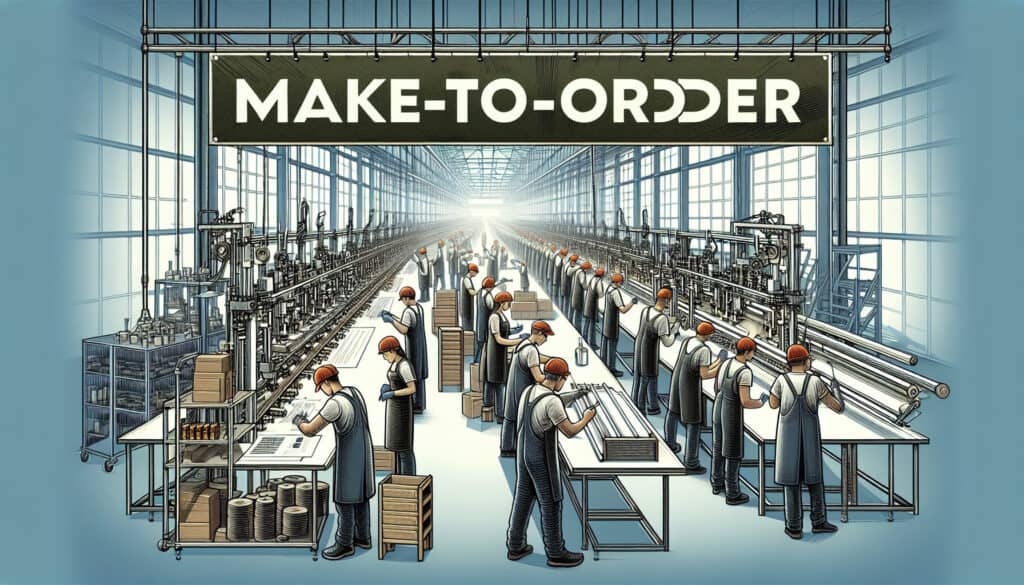To produce a product only after a customer has placed an order.
- Méthodologies : Ingénierie, Qualité
Make-to-Order (MTO)

Make-to-Order (MTO)
- Fabrication additive, Juste à temps (JIT), Production allégée, Conception de Produits, Développement de produits, Chaîne d'approvisionnement, Pratiques de durabilité, Proposition de valeur
Objectif :
Comment il est utilisé :
- A manufacturing strategy where production is initiated only after a confirmed customer order is received. This allows for a high degree of customization and reduces the risk of unsold inventory.
Avantages
- Allows for a high degree of customization; Reduces the risk of obsolescence and excess inventory.
Inconvénients
- Longer lead times for customers; Can be difficult to manage fluctuating demand.
Catégories :
- Lean Sigma, Fabrication
Idéal pour :
- Producing customized products such as high-end furniture, specialized machinery, or tailored clothing.
Make-to-Order (MTO) methodology is particularly effective in industries where customer preferences vary significantly and where the demand for unique products is strong, such as aerospace, automotive, custom machinery, and fashion design. This strategy can be implemented during various project phases, from design and prototyping to production and delivery. It necessitates close collaboration between designers, engineers, and clients to ensure that specifications are fully understood and met. MTO projects often involve the use of sophisticated customer relationship management tools and flexible manufacturing systems to adapt quickly to changing requirements, ensuring that products not only meet high standards but also align with clients’ evolving needs. Participants usually include sales teams who work directly with customers, design engineers who translate requests into specifications, and production teams skilled in handling custom builds. In applications like medical devices, where each product may need to conform to specific regulatory requirements, MTO provides a pathway to compliance while serving customer-specific demands. The iterative nature of the MTO process can also drive innovation, as customer feedback from early orders can inform the development of new products and improvements to existing lines, thus promoting a culture of continuous enhancement.
Principales étapes de cette méthodologie
- Receive confirmed customer order with product specifications.
- Review design requirements and feasibility of customization.
- Initiate production planning and resource allocation.
- Design prototypes or mock-ups as needed for approval.
- Commence manufacturing once designs are approved.
- Monitor production progress and quality control throughout.
- Make adjustments based on feedback or changes in specifications.
- Finalize product and prepare for delivery to the customer.
Conseils de pro
- Implement advanced analytics for accurate demand forecasting, allowing for better resource allocation and scheduling.
- Enhance communication between sales and production teams to ensure alignment on customization options and production feasibility.
- Invest in modular design principles to facilitate efficient customization while minimizing lead times and production costs.
Lire et comparer plusieurs méthodologies, nous recommandons le
> Référentiel méthodologique étendu <
ainsi que plus de 400 autres méthodologies.
Vos commentaires sur cette méthodologie ou des informations supplémentaires sont les bienvenus sur le site web de la Commission européenne. section des commentaires ci-dessous ↓ , ainsi que toute idée ou lien en rapport avec l'ingénierie.
Contexte historique
1949
1950
1950
1960
1960
1960
1960
1940
1950
1950
1958
1960
1960
1960
1960
(si la date est inconnue ou n'est pas pertinente, par exemple "mécanique des fluides", une estimation arrondie de son émergence notable est fournie)















Articles Similaires
Gestion des opérations de fabrication (MOM)
Système d'exécution de la fabrication (MES)
Plan de contrôle de la fabrication
Tests manuels
Tableaux d'évaluation des manutentions manuelles (MAC)
ManTRA (outil d'évaluation des risques liés aux tâches manuelles)